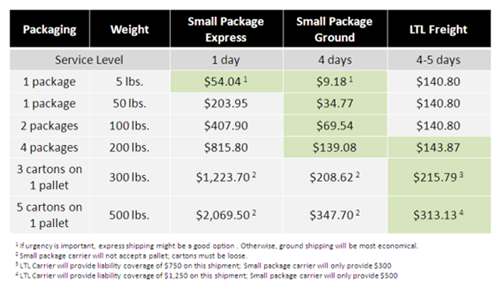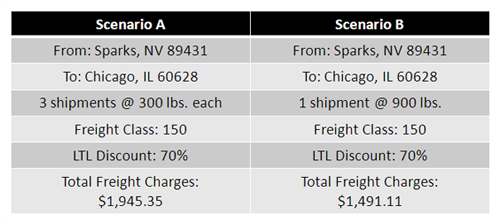- Categories:
Four Ideas to Reduce Shipping Costs
Here are four great ideas for reducing your shipping costs from the marketing folks at PartnerShip, the manager of the American Booksellers Association’ s shipping program for members.
Am I Overpaying for Shipping?
Shipping can be one of the most complicated — and costly — activities for any small business. Poor or no planning can result in overpayment, as well as lost sales if the business can’t provide consistent and cost-effective delivery to its customers.
Do you negotiate competitive discounts with your shipping providers? Do your purchase invoices include shipping and handling charges? If you answered “yes” to either of these questions, then you could very well be overpaying for your shipping.
Here are four ideas for you to consider to reduce your overall shipping costs:
#1 Obtain Discounts With Carriers
Most carriers — whether express, parcel or freight — provide discounts to businesses that routinely ship or receive merchandise. The old adage “everything is negotiable” is an immutable fact when it comes to shipping fees; however, the challenge for small businesses is how to go about obtaining the same, steep discounts that are normally reserved for large businesses and heavy freight shippers.
One tactic a small business should consider is joining an industry trade association. Oftentimes, industry trade associations are able to aggregate the buying clout of their members to negotiate and provide better shipping rates to all the businesses that participate in the program. PartnerShip®, the company that manages the ABA Shipping Program, is an example of a third party logistics provider that specializes in working with industry trade associations across the country to create discounted shipping programs for participating members.
Another approach a small business can take is to work directly with a third-party logistics provider (3PL), or even directly with their carriers, to see if they can get better discounts than they presently have. Often times if you simply ask for better pricing, you will get it because 3PLs and carriers are always looking to retain and grow their business. Be prepared to share examples of shipping invoices or manifests with your 3PL or carrier to help them best assess your shipping patterns and provide you with the best pricing. PartnerShip provides ABA members with a free shipping analysis service to help with this process.
#2 Develop an Inbound Shipping Management Program
One of the simplest and easiest ways to immediately cut inbound freight costs is to change your shipping terms from “prepaid and add” to “inbound collect.” Having a vendor or supplier ship collect on your recommended carrier eliminates any handling charges, thus saving you money.
When you gain more control over your inbound shipping, you can save on small package and freight shipments coming into your business every day. As the buyer and receiver of the goods, you can — and should — designate the carrier and arrange for shipping charges to be billed directly to you at your discounted rate. This is called routing shipments inbound “collect.”
In general, there are many benefits to having your inbound shipments routed collect. As the example below shows, it often saves a lot of money. But even if you don’t have shipping discounts that are better than your vendor, their handling mark-up could still make the overall shipping costs higher than your own.

Inbound shipping programs are often best managed through a third-party logistics provider. A good 3PL can help you develop routing instructions for your vendors, monitor compliance, and audit invoicing to ensure you’re saving the most on your inbound shipping.
#3 Use the Correct Mode & Service Level
A common dilemma for small businesses is choosing the appropriate shipping mode to use for their important shipments. Shipping mode choices include LTL freight, small package, ground, air, ocean, rail, intermodal, and others. When deciding whether to use a small package or LTL freight carrier, for example, shippers must take into consideration the weight and characteristics of the shipment, the shipment destination (e.g., business, residence, etc.), service needs, pricing and fees, and loss or damage concerns.
The table below provides examples of shipments of varying sizes moving across three different shipping modes. Each mode carries with it a certain level of cost, speed, and liability protection. Choosing the right mode will help your business maximize shipping costs and customer satisfaction.

#4 Consolidate Orders When Possible
As a general rule of thumb, one big order ships for less than three smaller orders. That means small businesses should consider consolidating multiple orders into a single shipment whenever possible and always strive to minimize the number of packages it sends. All too often, shipments are arranged as they come in from sales or order processing. However, a little planning and visibility go a long ways toward shipping savings as the table below shows.

Consolidating orders provides additional benefits to both shippers and receivers of small package and freight shipments, including:
- Reduced shipping supply expenses
- Greater fuel efficiency (better on the environment)
- Less time needed to receive, handle, and restock orders
One strategy for shipment consolidation is to create a simple shipping guide that takes into consideration all of your business rules for carriers, weight breaks, orders, and shipping contacts. Distribute this guide to your vendors and discuss it with your customers. A little communication can often go a long way towards small business savings.
In Summary
Shipping is an important cost factor for any small business that ships or receives materials or merchandise. It is often possible to reduce these costs with a little planning and effort. Utilizing some or all of these tips to control shipping costs can eliminate the strain shipping expenses put on your business. With the ABA Shipping Program, managed by PartnerShip, ABA members like you save on every shipment sent or received through the program. It is designed to help businesses reduce their shipping costs and positively impact their bottom line!

